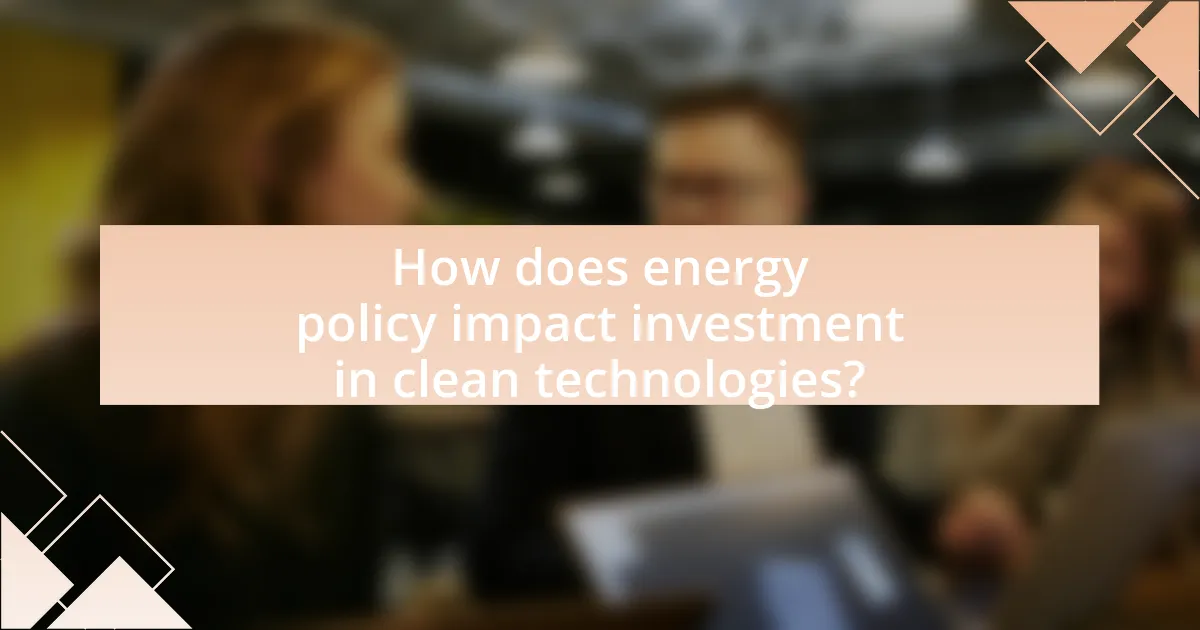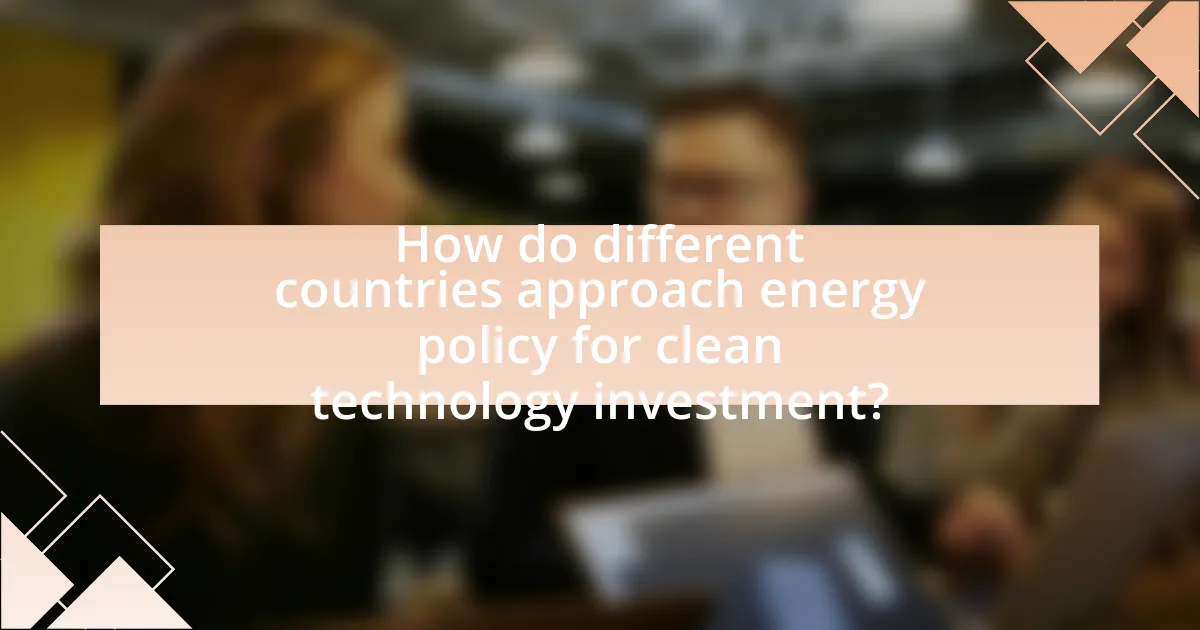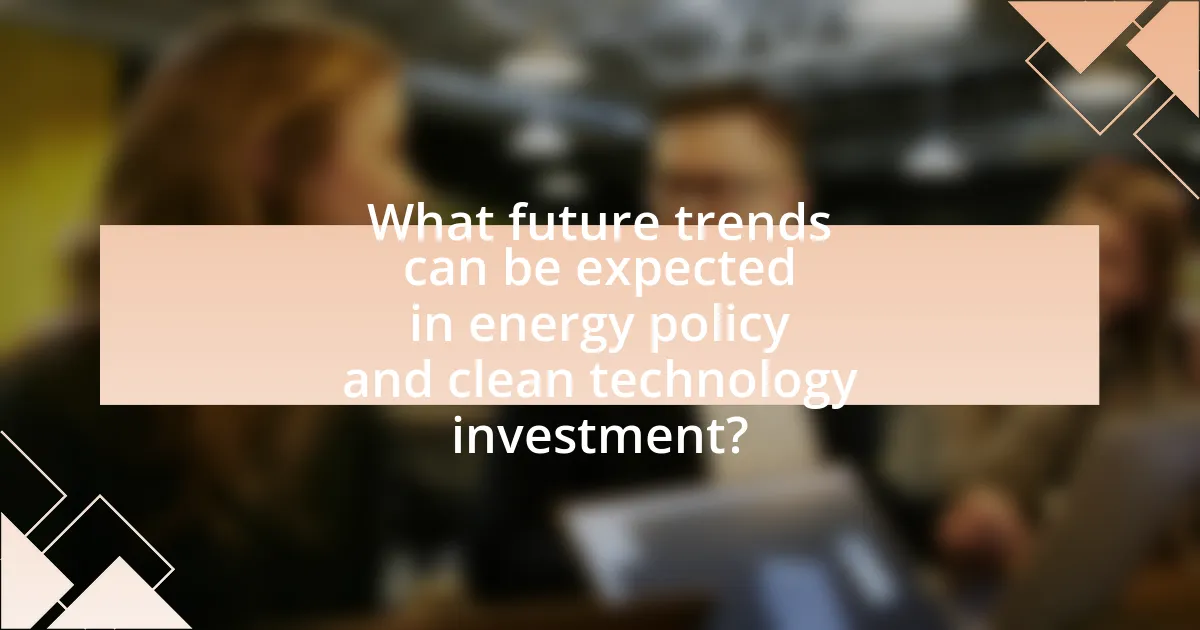Energy policy plays a crucial role in shaping investment in clean technologies by establishing regulatory frameworks, financial incentives, and market stability. Countries with supportive energy policies, such as Germany and China, have seen significant increases in clean technology investments, while regions with uncertain policies, like the U.S., have experienced declines. Key components influencing these investments include regulatory frameworks, subsidies, and market stability, which collectively guide capital towards sustainable solutions. The article explores how regulations, incentives, and international agreements impact investor confidence and the overall landscape for clean technology investments, highlighting the importance of stable energy policies for fostering innovation and growth in this sector.

How does energy policy impact investment in clean technologies?
Energy policy significantly impacts investment in clean technologies by establishing regulatory frameworks, financial incentives, and market signals that encourage or discourage investment. For instance, countries with strong renewable energy mandates and subsidies, such as Germany’s Energiewende, have seen substantial increases in investments in solar and wind technologies, with investments reaching over €20 billion annually. Conversely, regions with uncertain or unfavorable energy policies may deter investment, as seen in the U.S. during periods of regulatory rollback, where clean technology investments dropped by 20% in 2017. Thus, clear and supportive energy policies are crucial for fostering a conducive environment for clean technology investments.
What are the key components of energy policy that influence investments?
The key components of energy policy that influence investments include regulatory frameworks, financial incentives, and market stability. Regulatory frameworks establish the rules and standards for energy production and consumption, which can either encourage or deter investment in clean technologies. For instance, countries with stringent emissions regulations often see increased investment in renewable energy sources as companies seek to comply with legal requirements. Financial incentives, such as tax credits, subsidies, and grants, directly impact the attractiveness of investing in clean technologies by reducing upfront costs and improving return on investment. Market stability, characterized by predictable energy prices and demand, fosters investor confidence; for example, long-term power purchase agreements can secure revenue streams for renewable energy projects, making them more appealing to investors. These components collectively shape the investment landscape in the energy sector, guiding capital towards sustainable solutions.
How do regulations shape the investment landscape for clean technologies?
Regulations significantly shape the investment landscape for clean technologies by establishing frameworks that incentivize or restrict financial commitments in this sector. For instance, government policies such as tax credits, subsidies, and renewable energy mandates create a favorable environment for investors by reducing financial risks and enhancing potential returns. According to a report by the International Renewable Energy Agency, global investments in renewable energy reached $282 billion in 2019, largely driven by supportive regulatory frameworks. Additionally, stringent emissions regulations compel companies to invest in cleaner technologies to comply with legal standards, further directing capital towards sustainable solutions.
What role do subsidies and incentives play in promoting clean technology investments?
Subsidies and incentives significantly enhance clean technology investments by reducing financial barriers and increasing the attractiveness of such projects. These financial supports lower the initial capital costs associated with clean technologies, making them more competitive against traditional energy sources. For instance, the International Renewable Energy Agency reported that global investment in renewable energy reached $282 billion in 2019, partly due to government incentives and subsidies that encourage adoption. Furthermore, studies indicate that countries with robust subsidy programs, such as Germany and China, have seen accelerated growth in renewable energy capacity, demonstrating the effectiveness of these financial mechanisms in driving investment in clean technologies.
Why is energy policy critical for the growth of clean technologies?
Energy policy is critical for the growth of clean technologies because it establishes the regulatory framework and financial incentives necessary for innovation and investment. Effective energy policies, such as subsidies for renewable energy projects and emissions reduction targets, create a stable environment that encourages private sector investment in clean technologies. For instance, the U.S. Department of Energy reported that federal tax incentives for solar and wind energy have significantly increased their market share, demonstrating how supportive policies can drive technological advancement and deployment.
How does energy policy drive innovation in clean technology sectors?
Energy policy drives innovation in clean technology sectors by establishing regulatory frameworks and financial incentives that encourage research and development. For instance, government mandates for renewable energy adoption, such as the Renewable Portfolio Standards in the United States, compel companies to innovate in solar, wind, and other clean technologies to meet compliance requirements. Additionally, funding programs like the Department of Energy’s SunShot Initiative have allocated billions to reduce solar energy costs, fostering advancements in photovoltaic technologies. These policies create a competitive environment that stimulates private sector investment and accelerates technological breakthroughs, evidenced by the rapid decline in solar panel costs by over 80% since 2010, largely attributed to supportive energy policies.
What are the long-term effects of stable energy policies on investor confidence?
Stable energy policies significantly enhance investor confidence by providing a predictable regulatory environment. This predictability reduces perceived risks associated with investments in clean technologies, leading to increased capital allocation. For instance, countries with consistent renewable energy policies, such as Germany, have attracted substantial investments, with over €200 billion invested in renewable energy from 2000 to 2019, demonstrating a direct correlation between stable policies and investor commitment. Furthermore, stable energy policies foster long-term planning and innovation, as investors are more likely to commit resources to projects with a clear regulatory framework, ultimately driving growth in the clean technology sector.
What challenges do investors face due to fluctuating energy policies?
Investors face significant challenges due to fluctuating energy policies, primarily including uncertainty in returns and increased risk. This uncertainty arises from inconsistent regulations and incentives, which can lead to abrupt changes in market conditions. For instance, when governments shift their focus from renewable energy subsidies to fossil fuel support, investors may find their previously viable projects suddenly unprofitable. Additionally, fluctuating policies can hinder long-term planning, making it difficult for investors to commit capital to clean technology initiatives. According to a report by the International Renewable Energy Agency, policy instability can reduce investment in renewable energy by up to 40%, demonstrating the direct impact of energy policy fluctuations on investor confidence and financial viability.
How do policy changes affect the risk assessment for clean technology investments?
Policy changes significantly impact the risk assessment for clean technology investments by altering regulatory frameworks, financial incentives, and market dynamics. For instance, the introduction of subsidies or tax credits can reduce the perceived financial risk associated with investing in clean technologies, making them more attractive to investors. Conversely, the removal of such incentives can increase uncertainty and perceived risk, as seen in the U.S. solar market where changes in federal tax credits directly influenced investment levels. Additionally, stricter environmental regulations can create both opportunities and challenges; while they may drive innovation and demand for clean technologies, they can also impose compliance costs that heighten investment risk. Thus, the nature and direction of policy changes are critical in shaping the risk landscape for clean technology investments.
What strategies can investors use to navigate policy uncertainties?
Investors can navigate policy uncertainties by diversifying their portfolios, focusing on sectors less sensitive to regulatory changes, and employing scenario analysis to assess potential impacts. Diversification reduces risk by spreading investments across various asset classes, which can mitigate losses from adverse policy shifts. For instance, investing in renewable energy, energy efficiency technologies, and traditional energy sectors can balance exposure. Additionally, focusing on companies with strong fundamentals and adaptive business models can provide resilience against policy fluctuations. Scenario analysis allows investors to model different regulatory outcomes, enabling informed decision-making based on potential future states. This approach is supported by research indicating that diversified portfolios tend to perform better during periods of uncertainty, as evidenced by historical market data showing reduced volatility in diversified investments compared to concentrated ones.

How do different countries approach energy policy for clean technology investment?
Different countries adopt varied approaches to energy policy for clean technology investment, often influenced by their economic, environmental, and social contexts. For instance, countries like Germany implement aggressive renewable energy policies, such as the Energiewende initiative, which aims to transition to a sustainable energy system by promoting wind and solar power, supported by feed-in tariffs and substantial government subsidies. In contrast, the United States has a more fragmented approach, with states like California leading in clean technology investments through mandates and incentives, while federal policies can vary significantly depending on the administration in power. Additionally, China has emerged as a global leader in clean technology investment, driven by government policies that prioritize renewable energy development, including significant funding for solar and wind projects, as evidenced by its status as the largest producer of solar panels globally. These diverse strategies reflect how national priorities and resources shape the effectiveness of energy policies in fostering clean technology investments.
What are the variations in energy policies across major economies?
Major economies exhibit significant variations in energy policies, primarily influenced by their economic structures, resource availability, and environmental commitments. For instance, the United States emphasizes fossil fuel production and deregulation, while the European Union prioritizes renewable energy and stringent climate targets, aiming for carbon neutrality by 2050. China, as the largest emitter, has implemented aggressive policies to expand renewable energy capacity, targeting 1,200 gigawatts of solar and wind power by 2030. In contrast, India focuses on balancing economic growth with energy access, committing to 450 gigawatts of renewable energy by 2030. These differences reflect each economy’s unique approach to energy security, sustainability, and technological investment, shaping their respective clean technology landscapes.
How do developed countries differ from developing countries in their energy policies?
Developed countries typically prioritize renewable energy sources and implement stringent regulations to reduce carbon emissions, while developing countries often rely on fossil fuels and face challenges in establishing comprehensive energy policies. For instance, as of 2021, countries like Germany and Denmark have invested heavily in wind and solar energy, aiming for significant reductions in greenhouse gas emissions, whereas nations such as India and Nigeria still depend largely on coal and oil for energy needs due to economic constraints and infrastructure limitations. This disparity in energy policies influences investment in clean technologies, as developed nations create favorable conditions for innovation and deployment of renewables, while developing nations struggle to attract similar investments due to regulatory and financial barriers.
What lessons can be learned from successful clean technology investments in various countries?
Successful clean technology investments in various countries demonstrate the importance of strong government policies and incentives. For instance, Germany’s feed-in tariff system has significantly boosted solar energy adoption, leading to a 50% reduction in solar costs from 2010 to 2020. Additionally, Denmark’s commitment to wind energy has resulted in over 40% of its electricity coming from wind power, showcasing the effectiveness of long-term planning and investment in infrastructure. These examples illustrate that clear regulatory frameworks, financial incentives, and public-private partnerships are crucial for fostering innovation and attracting investment in clean technologies.
How do international agreements influence national energy policies?
International agreements significantly shape national energy policies by establishing frameworks that countries must adhere to in order to meet global standards and commitments. For instance, agreements like the Paris Agreement compel nations to set specific greenhouse gas reduction targets, which directly influence their energy strategies, pushing them towards renewable energy sources and away from fossil fuels. This shift is evidenced by the fact that countries participating in the Paris Agreement have committed to reducing their emissions, leading to increased investments in clean technologies, such as solar and wind energy, to meet these targets.
What impact do global climate agreements have on domestic clean technology investments?
Global climate agreements significantly enhance domestic clean technology investments by providing a framework that encourages countries to commit to emissions reduction targets. These agreements, such as the Paris Agreement, create regulatory certainty and stimulate market demand for clean technologies, leading to increased private sector investment. For instance, countries that ratified the Paris Agreement have seen a surge in renewable energy projects; the International Renewable Energy Agency reported that global renewable energy investments reached $300 billion in 2020, partly driven by commitments made under such agreements. This trend illustrates how international climate commitments can mobilize financial resources and innovation in domestic clean technology sectors.
How do trade policies intersect with energy policies in promoting clean technologies?
Trade policies intersect with energy policies by facilitating the import and export of clean technologies, thereby enhancing their adoption and development. For instance, tariffs on renewable energy equipment can be reduced to lower costs for domestic producers and consumers, promoting investment in solar and wind technologies. According to the International Renewable Energy Agency, countries that implement supportive trade policies alongside robust energy policies see a 20% increase in clean technology investments. This synergy encourages innovation and competitiveness in the clean energy sector, ultimately leading to a more sustainable energy landscape.

What future trends can be expected in energy policy and clean technology investment?
Future trends in energy policy and clean technology investment will increasingly focus on decarbonization, regulatory support for renewable energy, and advancements in energy storage technologies. Governments worldwide are committing to net-zero emissions targets, leading to policies that incentivize investments in solar, wind, and other renewable sources. For instance, the International Energy Agency reported that global renewable energy investment reached $300 billion in 2020, reflecting a significant shift towards sustainable energy solutions. Additionally, policies promoting electric vehicles and energy efficiency standards are expected to drive further investments in clean technologies, as evidenced by the Biden administration’s infrastructure plan, which allocates $174 billion for electric vehicle development. These trends indicate a robust alignment between energy policy and clean technology investment aimed at achieving sustainability goals.
How is the transition to renewable energy sources shaping future energy policies?
The transition to renewable energy sources is significantly shaping future energy policies by prioritizing sustainability and reducing carbon emissions. Governments worldwide are implementing policies that incentivize the adoption of renewable technologies, such as solar and wind energy, to meet international climate commitments like the Paris Agreement. For instance, the European Union’s Green Deal aims to make Europe the first climate-neutral continent by 2050, which directly influences national energy policies to promote clean energy investments. Additionally, financial mechanisms, such as tax credits and subsidies for renewable energy projects, are being established to encourage private sector investment, demonstrating a clear shift in policy focus towards sustainable energy solutions.
What emerging technologies are likely to benefit from future energy policies?
Emerging technologies likely to benefit from future energy policies include advanced energy storage systems, smart grid technologies, and renewable energy generation methods such as solar and wind. Advanced energy storage systems, like lithium-ion and solid-state batteries, are crucial for balancing supply and demand, especially as renewable energy sources become more prevalent. Smart grid technologies enhance energy efficiency and reliability by enabling real-time data management and integration of distributed energy resources. Additionally, policies promoting solar and wind energy can drive innovation in these sectors, as evidenced by the International Renewable Energy Agency reporting a 20% increase in global solar capacity in 2020 due to supportive policies.
How will public opinion and activism influence energy policy changes?
Public opinion and activism significantly influence energy policy changes by shaping political agendas and prompting legislative action. For instance, widespread public concern over climate change has led to increased support for renewable energy initiatives, as evidenced by the 2020 U.S. elections where candidates advocating for green policies gained substantial voter backing. Activist movements, such as Fridays for Future, have mobilized millions globally, pressuring governments to adopt more aggressive climate policies. This public pressure often results in policymakers prioritizing clean energy investments, as seen in the European Union’s Green Deal, which aims to achieve carbon neutrality by 2050, reflecting the demands of an environmentally conscious electorate.
What best practices should investors adopt in response to evolving energy policies?
Investors should adopt a proactive approach by diversifying their portfolios to include clean technologies and renewable energy sources in response to evolving energy policies. This strategy mitigates risks associated with regulatory changes and capitalizes on government incentives aimed at promoting sustainable energy solutions. For instance, the International Energy Agency reported that global investment in renewable energy reached $300 billion in 2020, highlighting the growing market potential driven by supportive policies. Additionally, investors should stay informed about policy developments and engage with industry experts to identify emerging opportunities and threats, ensuring their investment strategies remain aligned with the latest regulatory frameworks.
How can investors align their strategies with anticipated policy shifts?
Investors can align their strategies with anticipated policy shifts by closely monitoring government announcements and regulatory changes related to clean technologies. For instance, the U.S. government’s commitment to achieving net-zero emissions by 2050 has led to increased funding and incentives for renewable energy projects, which investors can capitalize on by reallocating their portfolios towards companies involved in solar, wind, and battery storage technologies. Historical data shows that sectors benefiting from favorable policies, such as the solar industry, have seen significant growth; for example, the U.S. solar market grew by 167% from 2010 to 2020, driven by supportive policies. By staying informed and adjusting investments in response to these policy trends, investors can enhance their potential returns while supporting the transition to a sustainable energy future.
What resources are available for investors to stay informed about energy policy changes?
Investors can utilize government websites, industry reports, and news outlets to stay informed about energy policy changes. Government websites, such as the U.S. Department of Energy and the International Energy Agency, provide official updates and policy announcements. Industry reports from organizations like Bloomberg New Energy Finance and the International Renewable Energy Agency offer in-depth analyses and forecasts. Additionally, reputable news outlets, including Reuters and The Wall Street Journal, cover significant policy developments and their implications for the energy sector. These resources collectively ensure that investors have access to timely and accurate information regarding energy policy changes.